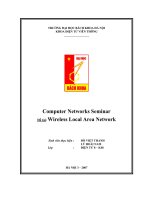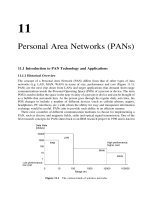Wireless networks - Lecture 40: High rate wireless personal area networks (WPAN)
Bạn đang xem bản rút gọn của tài liệu. Xem và tải ngay bản đầy đủ của tài liệu tại đây (346.7 KB, 26 trang )
Wireless Networks
Lecture 40
High Rate Wireless Personal Area Networks
(WPAN)
Dr. Ghalib A. Shah
1
Outlines
IP Over Bluetooth
Bluetooth Security
WPAN Standards
IEEE 802.15.3 Overview
802.15.3
►
►
Topology
Coordination
•
•
•
•
•
►
►
►
►
Starting a Piconet
Handing over control of piconet
Creating child piconet
Ending a Piconent
Association/Disassociation
Medium Access (Superframe)
Channel Time Management
Power management
MAC Frame format
2
Last Lecture
Bluetooth introduction
Technical features
Access technique
Bluetooth topology/scenario
Specifications
Architecture
Core Protocols
Packet format
Link connections
3
IP Over Bluetooth
IP over Bluetooth v
1.0
4
IP Over Bluetooth
IP over Bluetooth v
1.1
5
Security
User input (initialization)
PIN (1 – 16 bytes)
E2
Link key (128 bit)
E2
Encryption key (128 bit)
Pairing
Authentication key generation
(Possibly permanent storage)
Authentication
Encryption key generation
(Possibly permanent storage)
Encryption
Keystream generator
Payload key
E2
Link key (128 bit)
E2
Encryption key (128 bit)
Keystream generator
Ciphering
Cipher data
Data
PIN (1 – 16 bytes)
Payload key
6
Data
WPAN Standards
IEEE 802.15
standards
IEEE standard
Topic
Data throughput
802.15.1
Bluetooth
1 Mbps
802.15.2
Coexistence
of Bluetooth
and 802.11b
N/A
802.15.3
Highrate
WPAN
> 20 Mbps
802.15.4
Lowrate
WPAN
< 0.25 Mbps
Suitable applications
QoS needs
Cell phones, Computers, Personal Digital
Assistants (PDAs)/ Handheld Personal
Computers (HPCs), Printers, Microphones,
Speakers, Handsets, Bar Code Readers, Sensors,
Displays, Pagers and Cellular & Personal
Communications Service (PCS) phones
QoS suitable for
Voice
applications
N/A
N/A
Low power, Low cost solutions for portable
consumers of digital imaging and multimedia
applications
Very high QoS
Industrial, Agricultural, vehicular, Residential,
Medical applications, Sensors and actuators with
very low power consumption and low cost
Relaxed needs
for data rate and
QoS
7
IEEE 802.15.3 - Overview
High data rate WPAN
Potential future standard
Motivation: Data, High quality TV, Home
cinema
Dynamic topology
► Mobile devices often join and leave the
piconet
► Short connection times
Multiple Power Management modes
Secure Network
8
2.4 GHz PHY
► 4 channels (high density) or 3 channels (with
802.11b) modes are available
► Supports 5 data rates
•
•
•
•
11Mbps(QPSK)
22Mbps(DQPSK without coding)
33Mbps(16QAM)
44Mbps(32QAM), 55Mbps(64QAM)
9
IEEE 802.15.3 - Overview
Based on piconets in a person space analogous
to LAN in larger area
Data Devices (DEV) establish peer-to-peer
communication
Includes also a Piconet Coordinator (PNC)
► PNC manages the quality of service (QoS)
requirements, power save modes and access control to
the piconet.
A new piconet created with same channel as of
the existing PNC is called child/neighbor piconet
► If channel access is also controlled by the parent PNC
then it is called dependent piconet
10
IEEE 802.15.3 - Topology
11
802.15.3
IEEE 803.15.3 MAC is designed to support
the following goals:
►
►
►
►
►
►
Fast connection time
Ad hoc networks
Data transport with quality of service (QoS)
Security
Dynamic membership
Efficient data transfer
12
Coordination in IEEE 802.15.3
Starting a piconet
► DEV scans for the best channel and sends out beacons
-> the DEV becomes PNC
► If no channels available: Establishes a child or neighbor
piconet instead
► While the process of starting a piconet does not ensure
that the “most capable” PNC is initially selected
Handing over control of the piconet
► When a DEV associates, PNC checks the capabilities of
the new DEV to see if it is more capable to be the PNC
of the piconet
► In handover process, it maintains all existing time
allocations so that there is no interruption in the
delivery
13
Creating a child piconet
► A child piconet is one that is formed under an
established piconet. The established piconet
then becomes the parent piconet.
► The child piconet functionality is useful for
either extending the area of coverage of the
piconet or shifting some computational or
memory requirements to another PNC
capable DEV.
► The child piconet uses a distinct piconet ID
(PNID) and acts as an autonomous piconet
except that it is dependent on a private CTA
from the parent piconet.
14
Ending a piconet
► If the PNC is going to stop operation and there are no
other PNC capable DEVs in the piconet, the PNC places
the PNC Shutdown information element (IE) into the
beacon to notify the members of the piconet.
► In the case that the PNC abruptly leaves the piconet
without handing over control to another PNC capable
DEV in the piconet, the piconet stops operation.
► After the association timeout period (ATP) expires, a
PNC capable DEV from the old piconet will be able to
start a new piconet using the normal process,
► In the case of dependent piconets, the parent PNC is
able to end the dependent piconet via the
Disassociation Request command,
15
Association and disassociation
►
►
►
►
►
►
►
Associating with the piconet provides the DEV with a unique
identifier, the DEVID, for that piconet
The DEVID, one octet in length, is used instead of the DEV’s
address, 8 octets in length, to save overhead in the system.
The association process optionally provides information about
the services available in the piconet as well as the services
provided or PNC capabilities
PNC broadcasts the information about all of the DEVs in the
piconet, and places information in the beacon about the new
DEV.
When a DEV wants to leave the piconet or if the PNC wants to
remove a DEV from the piconet, the disassociation process is
used.
The DEVID of the disassociated DEV is no longer valid, until
reissued by the PNC.
However, the PNC is not allowed to reissue the DEVID until a
waiting period hasexpired
16
Security
Security for the piconet is one of two
modes
► Mode 0 Open:
• Security membership is not required and payload
protection (either data integrity or data encryption)
is not used by the MAC. The PNC is allowed to use a
list of DEV addresses to admit or deny entry to the
piconet.
► Mode 1—Secure membership and payload
protection:
17
IEEE 802.15.3 - Superframe
The super-frame is composed of three
parts:
► The beacon
• Which is used to set the timing allocations and to
communicate management information for the
piconet.
► The contention access period (CAP)
• Which is used to communicate commands and/or
asynchronous data if it is present in the superframe.
► The channel time allocation period (CTAP)
• Which is composed of channel time allocations
(CTAs), including management CTAs (MCTAs).
18
Superframe # m 1
Beacon #
m
Contention
access
period
Superframe # m
Superframe # m + 1
Channel time allocation period
MCTA
1
MCTA
2
Channel time is divided into
superframe with
Beacon
Contains piconet
synchronization parameter
and IE (Information
Element)s
CAP (Contention Access Period)
Optional. For command
frames and non-stream data.
Using CSMA/CA with backoff
scheme
CFP (Contention Free Period)
CTA 1
CTA 2
. . .
CTA
n1
CTA
n
The MCTAs are shown first,
but the PNC is allowed to
place any number of them at
any position in the
superframe.
19
IEEE 802.15.3 - CAP
CAP
► Allows contention via CSMA/CD
CTA
► The CTAP, uses a standard TDMA protocol where the
DEVs have specified time windows,
Contention Free Access
► To enable power saving and QoS
► CTA
•
•
•
Private CTA – for dependent piconet
Dynamic CTA – scheduled on a superframe by superframe
basis
Pseudo-Static CTA – only for isochronous stream. Allowed
to transmit during CTA as long as the number of
consecutive lost beacon is less then mMaxLostBeacons
20
Channel time management
There are three methods for
communicating data between DEVs in the
piconet:
► Sending asynchronous data in the CAP, if
present.
► Allocating channel time for isochronous
streams in the CTAP.
► Allocating asynchronous channel time in the
CTAP.
21
Dynamic channel selection
► Due to ISM bands, piconet is subject to interference
from unlicensed users or other 802.15.3 piconets
► PNC has the capability to dynamically change the
channel that the piconet is using without requiring
either user intervention or the disruption of services in
the piconet.
► To evaluate the status of the current channel as well as
other channels, the PNC is able to use many methods
including:
•
•
•
Gathering information about the current channel from
other DEVs in the piconet using the Channel Status
Request command.
Performing a passive scan of the channels.
Requesting other DEVs to perform a channel scan using
22
the Remote Scan Request command,
Power Management
standard provides three techniques to
enable DEVs to turn off for one or more
superframes:
► device synchronized power save (DSPS) mode
► piconet-synchronized power save (PSPS)
mode
► asynchronous power save (APS) mode.
PSPS
► PSPS mode allows DEVs to sleep at intervals
defined by the PNC.
► The DEV sends a request to the PNC when it
wants to enter the PSPS mode. 23
DSPS
► Besides allowing the DEVs to wake up and
exchange traffic at the same time, the use of
DSPS sets makes it easy for other DEVs in the
piconet to determine exactly when a DSPS
DEV will be available to receive traffic.
APS
► The only responsibility of a DEV in APS mode
is to communicate with the PNC before the
end of its ATP in order to preserve its
membership in the piconet.
24
MAC Frame format
Octets: 0 or 4
L
n
FCS
Frame payload
bits: b23
b22b16
b15b9
b8b0
Reserved
Last fragment number
Fragment
number
MSDU number
1
3
1
1
2
2
Stream
index
Fragmentation control
SrcID
DestID
PNID
Frame
control
MAC header
MAC frame body
bits: b15
b11
b10
b9
b8b7
b6
b5b3
b2b0
Reserved
More data
Retr
y
ACK
policy
SE
C
Frame type
Protocol
version
25









